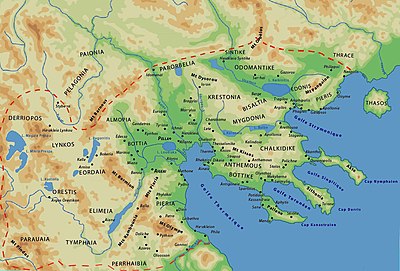Parauaia
Parauaia ( Greek Παραυαία ) referred to an ancient Greek landscape in Epiros , which was settled by the Epirotic tribe of the Parauaians ( Παραυαῖοι ). Geographically, it comprised the Pindus Mountains , located in what is now the border region between Greece and Albania . The Aoos (Vjosa) flowed through it .
In the north, the country was bounded by the upper reaches of the Aliakmonas with the Macedonian Orestes settling on the other side , while in the east the Tymphaians , in the northwest the Chaonians , in the southeast the Molossians and in the south the Atintans settled.
Under their king Oroidos, the Parauaians, who were joined by a thousand Orestes, supported 429 BC. The Spartans at the siege of Plataiai and fought in the battle of Stratos . In the middle of the 4th century BC Parauaia was conquered by Philip II , after which it was added to the Upper Macedonian landscapes . Since then it has formed the most south-westerly border region of the Macedonian kingdom . In 335 BC Chr. Had Alexander the Great this landscape on his twelve-day march of Pelion Dassaretia to Thebes crossed.
King Alexander V had in 294 BC BC Parauaia as well as Tymphaia have to cede to them for the help of the Epirot king Pyrrhus . To what extent these areas reverted to Macedonia after his death is controversial, but they probably remained in the Epirot League until the Roman conquest.
literature
- Fritz Geyer: Macedonia up to Philip II's accession to the throne. In: Historische Zeitschrift , Vol. 30 (1930), pp. 1–148.
- John Van Antwerp Fine: The Problem of Macedonian Holdings in Epirus and Thessaly in 221 BC In: Transactions and Proceedings of the American Philological Association , Vol. 63 (1932), pp. 126-155.
